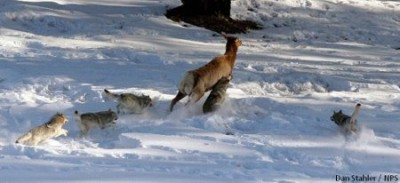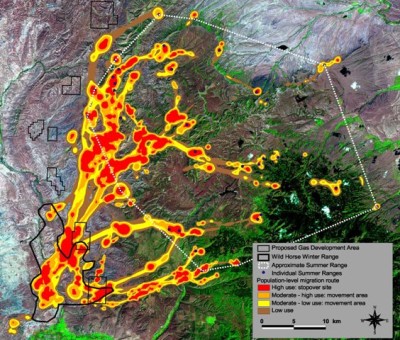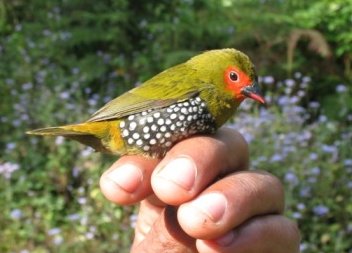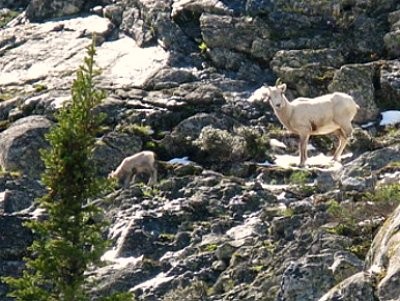Primary research areas
Our research is focused on animal ecology and conservation, with an emphasis on individual, population, and community-level dynamics of large mammals (ungulates and carnivores). Our work encompasses both basic and applied aspects of ecology and is generally directed towards the management and conservation needs of Wyoming’s large mammals. Current research efforts of our group fall into four conceptual focus areas:
Trophic interactions among large mammals
 Predators can influence prey populations in both direct and indirect ways – both by killing them and by changing their behavior. Much of our recent work has focused on indirect pathways, and seeks to understand the ways in which the predation risk from wolves influences antipredator behavior in elk. Previous work has evaluated how landscape heterogeneity creates gradients in the risk of wolf predation on elk in Yellowstone National Park, and we are also evaluating the behavioral basis of elk antipredator behavior (i.e., vigilance, movement, grouping). These investigations include examination of the potential community-level effects of predation risk, specifically so-called ‘behaviorally mediated trophic cascades’ involving wolves, elk and aspen. A current study, the Absaroka Elk Ecology Project, is evaluating factors that might influence the strength of elk antipredator behavior in response to wolves. We are particularly interested in elucidating the manner in which prey body condition mediates – and is mediated by – the strength of antipredator behavior. As for the direct effects of predators, several of our studies are evaluating the influence of wolf and grizzly bear predation on ungulate calf production. Recent work on wolf-cattle interactions is also exploring how the distribution of native prey influences carnivore movements to drive the spatiotemporal dynamics of carnivore-livestock conflicts.
Predators can influence prey populations in both direct and indirect ways – both by killing them and by changing their behavior. Much of our recent work has focused on indirect pathways, and seeks to understand the ways in which the predation risk from wolves influences antipredator behavior in elk. Previous work has evaluated how landscape heterogeneity creates gradients in the risk of wolf predation on elk in Yellowstone National Park, and we are also evaluating the behavioral basis of elk antipredator behavior (i.e., vigilance, movement, grouping). These investigations include examination of the potential community-level effects of predation risk, specifically so-called ‘behaviorally mediated trophic cascades’ involving wolves, elk and aspen. A current study, the Absaroka Elk Ecology Project, is evaluating factors that might influence the strength of elk antipredator behavior in response to wolves. We are particularly interested in elucidating the manner in which prey body condition mediates – and is mediated by – the strength of antipredator behavior. As for the direct effects of predators, several of our studies are evaluating the influence of wolf and grizzly bear predation on ungulate calf production. Recent work on wolf-cattle interactions is also exploring how the distribution of native prey influences carnivore movements to drive the spatiotemporal dynamics of carnivore-livestock conflicts.
Related projects
Related papers
Kauffman, M.J., N. Varley, D.W. Smith, D. Stahler, D. MacNulty, and M.S. Boyce. 2007. Landscape heterogeneity shapes predation in a newly restored predator-prey system. Ecology Letters 10:690–700. View PDF
Kauffman, M.J., J. Brodie, and E.S. Jules. 2010. Are wolves saving Yellowstone’s aspen? A landscape-level test of a behaviorally mediated trophic cascade. Ecology 91:2742-2755. View PDF
Middleton, A.D., M.J. Kauffman, D.E. McWhirter, J.G. Cook, R.C. Cook, A.A. Nelson, M.D. Jimenez, and R.W. Klaver. In press. Animal migration amid shifting patterns of phenology and predation: lessons from a Yellowstone elk herd. Ecology.
Nelson, A.A, M.J. Kauffman, A.D. Middleton, M.D. Jimenez, D.E. McWhirter, J. Barber, and K. Gerow. In press. Elk migration patterns and human activity influence wolf habitat use in the Greater Yellowstone Ecosystem. Ecological Applications. View PDF
Ecology and conservation of ungulate migrations
 Sustaining ungulate migrations has become a conservation goal in the western US and across the globe. Although there is strong support for the conservation of ungulate migrations, several research gaps remain that, if filled, could improve conservation efforts. Wyoming is home to wide open spaces and many ungulate herds that are still migratory, offering an ideal opportunity to study ungulate migration. Our research program is addressing several basic and applied aspects of ungulate migration ecology. These include: i) evaluatingmule deer migration route networks for conservation prioritization (right), ii) characterizing the stopover ecology of ungulate migrations, iii) quantifying the influence of climate change on the benefits of migration in elk, iv) evaluating the factors that mediate the cost and benefits of migration for migratory and non-migratory populations, v) determining threshold levels of development that impede unglate migration route use across multiple species, vi) characterizing the high-elevation foraging strategies of a recently migratory, but now sedentary, population of bighorn sheep, and vii) evaluating the influence of winter feeding on elk migrations and summer foraging. An applied goal of this work is to inform regional conservation plans to sustain ungulate migrations in Wyoming and across the West.
Sustaining ungulate migrations has become a conservation goal in the western US and across the globe. Although there is strong support for the conservation of ungulate migrations, several research gaps remain that, if filled, could improve conservation efforts. Wyoming is home to wide open spaces and many ungulate herds that are still migratory, offering an ideal opportunity to study ungulate migration. Our research program is addressing several basic and applied aspects of ungulate migration ecology. These include: i) evaluatingmule deer migration route networks for conservation prioritization (right), ii) characterizing the stopover ecology of ungulate migrations, iii) quantifying the influence of climate change on the benefits of migration in elk, iv) evaluating the factors that mediate the cost and benefits of migration for migratory and non-migratory populations, v) determining threshold levels of development that impede unglate migration route use across multiple species, vi) characterizing the high-elevation foraging strategies of a recently migratory, but now sedentary, population of bighorn sheep, and vii) evaluating the influence of winter feeding on elk migrations and summer foraging. An applied goal of this work is to inform regional conservation plans to sustain ungulate migrations in Wyoming and across the West.
Related projects
- Mule Deer Migration Project
- Absaroka Elk Ecology Project
- Ungulate Migration and Development Project
- Teton Bighorn Sheep Project
- Jackson Moose Project
- Elk Nutritional Condition Project
- Migration Corridors and Landscape Connectivity Project
Related papers
Sawyer, H.S., M.J. Kauffman, R.M. Nielson and J. Horne. 2009. Identifying and prioritizing ungulate migration routes for landscape-level conservation. Ecological Applications 19:2016-2025. View PDF
Sawyer, H.S., M.J. Kauffman. 2011. Stopover ecology of a migratory ungulate. Journal of Animal Ecology 80:1078-1087.
Middleton, A.D., M.J. Kauffman, D.E. McWhirter, J.G. Cook, R.C. Cook, A.A. Nelson, M.D. Jimenez, and R.W. Klaver. In press. Animal migration amid shifting patterns of phenology and predation: lessons from a Yellowstone elk herd. Ecology.
Nelson, A.A, M.J. Kauffman, A.D. Middleton, M.D. Jimenez, D.E. McWhirter, J. Barber, and K. Gerow. In press. Elk migration patterns and human activity influence wolf habitat use in the Greater Yellowstone Ecosystem. Ecological Applications. View PDF
Demography and population dynamics
 The dynamics of animal populations, including their response to human disturbance, are often best understood through the quantitative evaluation of their demography. Our research group has broad interest in the factors that influence the demography of animal populations and the means by which we understand how demographic variation translates into population dynamics. The demography of many real-world populations is complicated by our understanding of movement, dispersal, and differential demography of individuals occupying different habitat patches. Our research addresses the influence of such spatially structured demography for wildlife populations. For example, early work by Kauffman showed that spatially-structured populations strongly influenced the recovery of peregrine falcons in California. A current project in the lab is using as 23-year data set to evaluate how 20 different species of understory birds respond to tropical forest fragmentation in a biodiversity hotspot in Tanzania. Work on a moose population near Grand Teton and Yellowstone National Parks is quantifying moose demography as a function of the unique high-elevation summer ranges used by individuals and their offspring. We are always in search of better analytical techniques to study animal demography, and several previous and current projects have contributed to such methodological advances.
The dynamics of animal populations, including their response to human disturbance, are often best understood through the quantitative evaluation of their demography. Our research group has broad interest in the factors that influence the demography of animal populations and the means by which we understand how demographic variation translates into population dynamics. The demography of many real-world populations is complicated by our understanding of movement, dispersal, and differential demography of individuals occupying different habitat patches. Our research addresses the influence of such spatially structured demography for wildlife populations. For example, early work by Kauffman showed that spatially-structured populations strongly influenced the recovery of peregrine falcons in California. A current project in the lab is using as 23-year data set to evaluate how 20 different species of understory birds respond to tropical forest fragmentation in a biodiversity hotspot in Tanzania. Work on a moose population near Grand Teton and Yellowstone National Parks is quantifying moose demography as a function of the unique high-elevation summer ranges used by individuals and their offspring. We are always in search of better analytical techniques to study animal demography, and several previous and current projects have contributed to such methodological advances.
Related projects
Related papers
Kauffman, M.J., W.F. Frick and J. Linthicum. 2003. Modeling habitat-specific differences in survival, fecundity, and population growth for peregrine falcons in California. Ecological Applications 13:1802–1816. View PDF
Kauffman, M.J., J.F. Pollock and B. Walton. 2004. Spatial structure, dispersal, and management of a recovering raptor population. American Naturalist 164:582-597. View PDF
Kauffman, M.J., and J.L. Maron. 2006. Consumers limit the abundance and dynamics of a perennial shrub with a seed bank. American Naturalist 168:454-470. View PDF
Raithel, J.D., M.J. Kauffman, D.H. Pletscher. 2007. Impact of spatial and temporal variation in calf survival on the growth of elk populations. Journal of Wildlife Management 71:795-803. View PDF
Harris, N.C, M.J. Kauffman, L.S. Mills. 2008. Ungulate population demography and dynamics from age ratios. Journal of Wildlife Management 72:1143-1151. View PDF
Barclay, J., N. Korfanta, and M.J. Kauffman. In revision. Long-term population dynamics of a managed burrowing owl colony.
Morrison, TA, and M.J. Kauffman. Mule Deer Modeling Report: A quantitative evaluation of survey efforts to model, monitor and manage Wyoming mule deer populations.
Foraging and habitat selection
 Much of our work evaluates the foraging and habitat selection of large mammals. Evaluation of habitat has clear benefits for management, but also can help provide a more mechanistic understanding of demography and population-level processes. Several of our projects focus on the tradeoffs animals make in foraging and habitat selection. In mule deer, we have evaluated tradeoffs associated with winter foraging and avoidance of energy development infrastructure. In elk, we are evaluating how individuals alter their foraging and habitat selection to balance the risk of wolf predation with the risk of winter starvation. In bighorn sheep, we are evaluating whether sheep avoid mountain habitat used by backcountry skiers. In wolves, we are evaluating the tradeoffs that these carnivores make to balance their access to prey with disturbance from humans. A growing focus of our habitat selection work is connecting such behavioral strategies to their fitness consequences. We are evaluating the influence of summer range condition on moose demography and the influence of wolf-induced habitat shifts on elk nutrition, pregnancy, and calf recruitment. Much of this work has started to evaluate individual variation in foraging strategies, either as a function of cultural history or body condition. For example, we have evaluated whether translocated bighorn sheep from three different source herds differ in the way they use the same novel, introduced habitat. We are also evaluation how supplemental feeding of elk during winter might alter their foraging strategies throughout the rest of the year, namely migration and summer range habitat selection and foraging ecology.
Much of our work evaluates the foraging and habitat selection of large mammals. Evaluation of habitat has clear benefits for management, but also can help provide a more mechanistic understanding of demography and population-level processes. Several of our projects focus on the tradeoffs animals make in foraging and habitat selection. In mule deer, we have evaluated tradeoffs associated with winter foraging and avoidance of energy development infrastructure. In elk, we are evaluating how individuals alter their foraging and habitat selection to balance the risk of wolf predation with the risk of winter starvation. In bighorn sheep, we are evaluating whether sheep avoid mountain habitat used by backcountry skiers. In wolves, we are evaluating the tradeoffs that these carnivores make to balance their access to prey with disturbance from humans. A growing focus of our habitat selection work is connecting such behavioral strategies to their fitness consequences. We are evaluating the influence of summer range condition on moose demography and the influence of wolf-induced habitat shifts on elk nutrition, pregnancy, and calf recruitment. Much of this work has started to evaluate individual variation in foraging strategies, either as a function of cultural history or body condition. For example, we have evaluated whether translocated bighorn sheep from three different source herds differ in the way they use the same novel, introduced habitat. We are also evaluation how supplemental feeding of elk during winter might alter their foraging strategies throughout the rest of the year, namely migration and summer range habitat selection and foraging ecology.
Related projects
- Mule Deer Migration Project
- Absaroka Elk Ecology Project
- Absaroka Wolf-Livestock Project
- Teton Bighorn Sheep Project
- Elk Nutritional Condition Project
Related papers
Kauffman, M.J., N. Varley, D.W. Smith, D. Stahler, D. MacNulty, and M.S. Boyce. 2007. Landscape heterogeneity shapes predation in a newly restored predator-prey system. Ecology Letters 10:690–700. View PDF
Kauffman, M.J, M.A. Sanjayan, J. Lowenstein, A. Nelson, R.M. Jeo and K.R. Crooks. 2007. Using remote photography methods and analyses to assess the conservation value of rangelands for Namibian carnivores. Oryx 41:70-78.
Sawyer, H.S., M.J. Kauffman, and R.M. Nielson. 2009. Influence of well pad activity on the winter habitat selection patterns of mule deer. Journal of Wildlife Management 73:1052-1061. View PDF
Nelson, A.A, M.J. Kauffman, A.D. Middleton, M.D. Jimenez, D.E. McWhirter, J. Barber, and K. Gerow. In press. Elk migration patterns and human activity influence wolf habitat use in the Greater Yellowstone Ecosystem. Ecological Applications. View PDF
Kauffman, M.J. et al. In prep. Habitat selection and group association of translocated bighorn sheep (Ovis canadensis) in north-central Wyoming: does source herd matter


